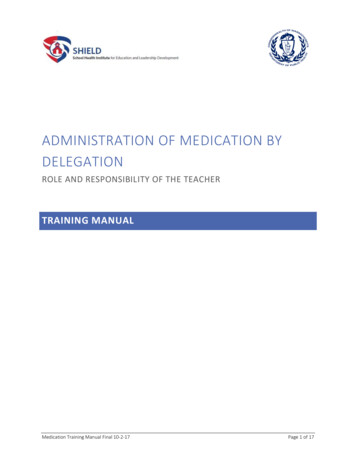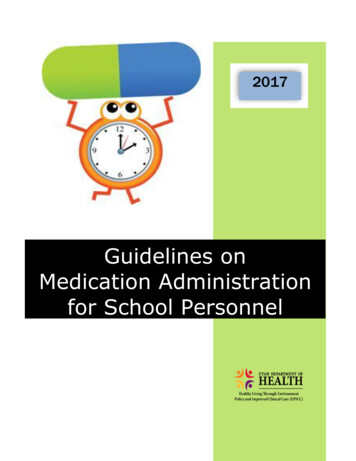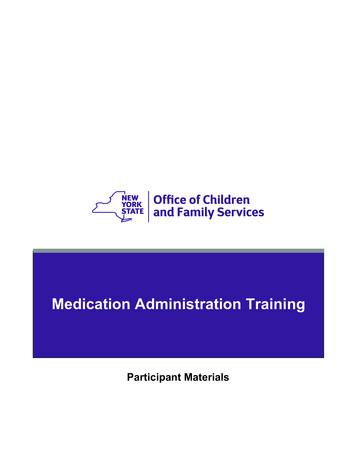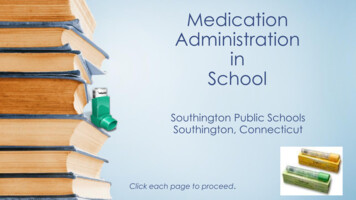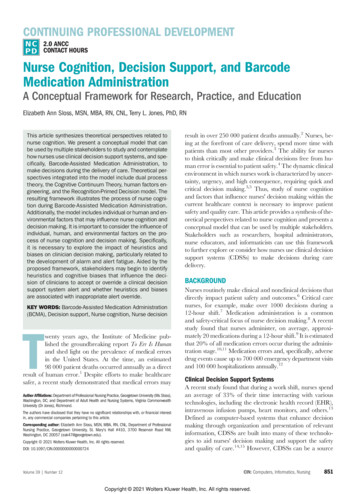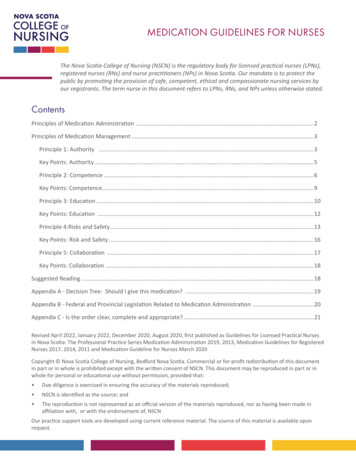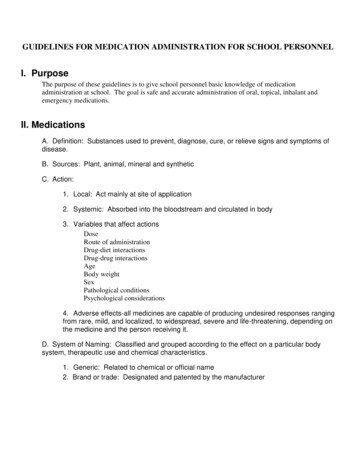
Transcription
GUIDELINES FOR MEDICATION ADMINISTRATION FOR SCHOOL PERSONNELI. PurposeThe purpose of these guidelines is to give school personnel basic knowledge of medicationadministration at school. The goal is safe and accurate administration of oral, topical, inhalant andemergency medications.II. MedicationsA. Definition: Substances used to prevent, diagnose, cure, or relieve signs and symptoms ofdisease.B. Sources: Plant, animal, mineral and syntheticC. Action:1. Local: Act mainly at site of application2. Systemic: Absorbed into the bloodstream and circulated in body3. Variables that affect actionsDoseRoute of administrationDrug-diet interactionsDrug-drug interactionsAgeBody weightSexPathological conditionsPsychological considerations4. Adverse effects-all medicines are capable of producing undesired responses rangingfrom rare, mild, and localized, to widespread, severe and life-threatening, depending onthe medicine and the person receiving it.D. System of Naming: Classified and grouped according to the effect on a particular bodysystem, therapeutic use and chemical characteristics.1. Generic: Related to chemical or official name2. Brand or trade: Designated and patented by the manufacturer
E. Classification of drugs1. Prescription: Medications including controlled substances which require aprescriber’s order2. Over the counter (OTC): Drugs which may be purchased without a prescription,e.g., first aid cream, analgesics and antacids3. Schedules of Controlled Substances: Five schedules of drugs and drug productsunder the jurisdiction of the Controlled Substances Act. Some examples are listed.Listings are subject to change. For a complete list, contact the Drug EnforcementAdministration or a pharmacist.a) Schedule I. Substances that have no accepted medical use in the U.S. and have a highabuse potential (heroin, marijuana, LSD, etc.)b) Schedule II. Substances that have a high abuse potential with severe psychic orphysical dependence liability. No prescription renewals are permitted. Consists ofcertain narcotic, stimulant and depressant drugs (opium, codeine, Demerol, percodan,Dexedrine, Ritalin)c) Schedule III. Substances that have some potential for abuse. Use may lead to low-tomoderate physical dependence or high psychological dependence. Includes compoundswith limited quantities of certain narcotic drugs and non-narcotic drugs (Doriden,compound or mixture containing secobarbital).d) Schedule IV. Substances with low potential for abuse. Use may lead to limitedphysical or psychological dependence (Phenobarbital, Placidyl, Librium, Valium,Tranxene, Darvon, Talwin-NX)e) Schedule V. Substances subject to state and local regulation. Abuse potential is low.Limited quantities of certain narcotic and stimulant drugs generally for antitussive,antidiarrheal and analgesic purposes.III.School medication administration guidelinesA. Parents are notified about the school medication administration policy for students throughthe student handbook given to all students at the beginning of school or at enrollment.B. VISD employees may administer medication with:1. A parent’s written request that there is a need for such medication and the parentprovides the medication. This includes both prescription and OTC drugs. All medicationprovided by the parent must have the Medication Authorization paper work filled out bythe parent or guardian and turned in to the Health Office. Any prescription medicationmust be brought to the school by the parent or guardian. For the Jr. High and Highschool campuses, over the counter medication may be brought to school by the studentwith the proper medication authorization paperwork fill out by the parent or guardian.
2. If the medication is a prescription, it must be:a) Filled by a pharmacist licensed to practice in the United Statesb) In a clearly labeled prescription bottle with the student’s name, medication name, anddirections for dispensing the drugc) Kept in the school nurse office and administered by the school nurse or principal’sdesigneed) Documented by a note from the student’s physician if the medication dosage has beenchanged from the label directionsC. Medication may be administered to students by any VISD employee assigned to the taskby the building principal.D. Confidentiality should be maintained concerning medication information.E. Medication administration should be recorded with the student’s name, medication, dose,date, time, route, and signature/initials of the person administering the medication.F. There should be an Emergency Care Plan in place for any student who may need anemergency injection (Epi-Pen)G. Any student with a suspected allergic reaction to a medication or other substance shouldbe assessed and monitored by the school nurse.H. VISD personnel/principal’s designee are not permitted to give medications of any kind,including aspirin, similar preparations, or any other drugs, unless the parent requests in writingand provides the medication.I. All medication should be kept in a locked cabinet.J. Unused medication must be picked up by parent/guardian within two weeks ofdiscontinuation. If the medication is not picked up, it will be properly disposed of by healthservices personnel. At the end of the school year, all medications left in the office will bedisposed of at the end of the last day of school.IV. “Five Rights of Medication Administration”A. Right Student – Properly identifies studentB. Right Time – Administers medication at the prescribed timeC. Right Medicine – Administers the correct medicationD. Right Dose – Administers the right amount of medicationE. Right Route – Uses the prescribed method of medication administration
V.Steps in school medication administrationA. Follow school district policy for administering medications to students1. Wash hands. Administration of medication is a clean procedure.2. Verify the authorization with the label. Seek information for questions and dosecalculations.3. Gather necessary items.4. Prepare and give medications in a well lit area5. Check the label for name, time, medication dose, and route when picking up themedication bottle.6. Prepare the correct dosage of medication without touching medication if possible.7. Check the label for name, time, medication dose, and route while preparing thecorrect dose.8. Check the label for name, time, medication dose, and route before returningcontainer to the locked cabinet.9. Do not leave medication unattended or within the reach of the student.10. Observe the student for any unusual behaviors or conditions prior to medicationadministration. If any noted, do not give the medication, report immediately ad record.11. Explain procedure to student.12. Position the student properly for medication administration.13. Provide equipment and supplies as needed.14. Administer the correct dose of medication to the correct student, at the correct time,by correct route.15. Observe the student place medication in his/her mouth.16. Record as soon as possible name, time, medication dose, route, personadministering the medication and any unusual observations.17. Clean, return and/or dispose of equipment as necessary.18. Wash hands.B. Errors and omissions in medication administration1. Report medication errors immediately to school nurse, administrator, parents, and/orphysician.
2. Complete medication error form.3. Observe student and record and report any changes.C. Recording and reporting1. Record immediately after administering medication if possible.2. Errors in recording should be marked through and initialed.3. Record omissions, absence, or refusalsVI. Procedures for administering medicationsA. Oral Medication1. Oral bottled medication:a. Remove bottle cap and hold the cap in one hand and bottle in the other hand.b. Pour the prescribed dose into the cap.c. Pour medicine from cap into student’s hand.d. Give with a full glass of water unless otherwise indicated. Follow special labelinstructions (e.g., take with milk)e. Observe the student place the medication in his/her mouth.f. Recap bottle and return it to locked cabinet.g. Refer partial pill dosage to school nurse.2. Oral individually wrapped medications:a. Remove or tear off number needed and place package in a medicine cupb. Remove and transfer to cup when student takes medication3. Oral liquid or powders:a. Shake medication per label instructions.b. Pour liquid from side of bottle opposite the label (hold label in palm of hand) intograduated medicine cup.c. Pour medication at eye level and directly in front of eyes.d. Measure the dosage at the bottom of the disc (meniscus).e. Wipe off any medication on the outside of the container.f. Use calibrated medicine dropper or syringe to measure small amounts of liquid.g. Hold medicine dropper at right angle to cup to measure drops.h. Pour liquid medications into separate containers unless otherwise ordered.i. Give cough syrup undiluted and do not follow with water.4. Problems with oral medication administration:a. Refusal of Medication – Record on medication sheet. Report to school nurse and/orparent.
b. Vomiting Medication – Record medication and dosage and time lapse sinceadministration and if medication was intact in vomitus. Call school nurse and/orparent.c. Suggestions for students with difficulty swallowing medications:1. Position student in upright position2. Give one medication at a time with adequate fluids3. Place medicine on back of tongue4. Give liquid medications slowly5. Watch for choking6. Observe the student place the medication in his/her mouth7. Give medication with other food or crushed if directedB. Skin (topical) Medications1. Gather necessary equipment such as tongue blade, gauze, tape, cleansing material,cotton-tipped applicator. If skin is broken or open lesions, use gloves.2. Note condition of affected area. If unusual, report before applying medication.3. Cleanse skin gently, removing previously applied medication and apply medicationin a thin layer or as ordered.4. Record any changes seen in skin area treated. Notify school nurse of any change.5. Cover as ordered.C. Eye drops. Use only preparations labeled for ophthalmic use.1. Gather necessary equipment: cotton balls and tissues. If there is drainage from theeye, use gloves.2. Observe affected eye for any unusual condition and report before medication isapplied.3. If needed, cleanse eye with clean cotton ball wiping once from inside to outside.Use clean cotton ball for each eye.4. Position student with head tilted back and eyes looking up.5. Open eye to expose conjunctival sac (lower inside lid).6. Approach eye from outside the field of vision. Avoid touching the dropper tip toanything.7. Hold the dropper approximately one inch from the eye. Drop the medication gentlyinto the sac, not on the eyeball. Wait 1-5 minutes between instillations if more than onedrop is ordered.8. Gently close eye. Ask student to keep eye closed for a few minutes.
9. Blot excess medication with a clean cotton ball or tissue.D. Eye Ointment1. Gather necessary equipment : cotton balls and tissues. If there is drainage from theeye, use gloves.2. Observe affected eye(s) for any unusual condition. Report to school nurse.3. Cleanse eye with clean cotton ball, if necessary. Wipe once from inside to outside.Use a clean cotton ball for each eye.4. Position student with head tilted back and eyes looking up.5. Open eye to expose conjunctival sac.6. Approach eye from outside the field of vision. Avoid touching the dropper tip toanything.7. Hold the dropper approximately one inch from the eye. Drop the medication gentlyinto the sac, not on the eyeball. Wait 1-5 minutes between instillations if more than onedrop is ordered.8. Gently close eye. Ask student to keep eye closed for a few minutes.9. Blot excess medication with a clean cotton ball or tissue.E. Ear drops1. Gather necessary equipment: cotton balls and tissues. Use gloves if drainage mustbe cleaned from the ear.2. Position the student.a. If lying flat on a cot, turn face to opposite side.b. If sitting in chair, tilt head sideways until ear is horizontal.3. Cleanse entry to ear canal with clean cotton ball as needed.4. Observe affected area for any unusual condition, report to school nurse.5. Straighten the ear canal, pull outer ear gently down and back (ages 3 and under) orup and back (older children).6. Drop the medication on the side of the canal. Avoid the dropper touching anything
7. Instruct the student to maintain the required position for one minute. Gently rub theskin in front of the ear to assist the medication to flow to the inside of the ear.8. If the other ear is to be treated, repeat procedure after one minute-wait.9. Loosely place a cotton ball in the ear as ordered.F. Medication InhalerInstruct student to:1. Stand up, feet slightly apart.2. Shake inhaler for approximately two seconds.3. Position inhaler with canister upside-down above mouthpiece.4. Hold mouthpiece 1-2 inches from lips and open mouth wide. If a spacer or reservoiris used, place mouthpiece in mouth.5. Breathe out naturally.6. Open mouth wide and begin to inhale a deep breath slowly. If using a spacer, sealmouth around mouthpiece and inhale a deep breath.7. After beginning of deep breath, squeeze canister down on mouthpiece and breatheas slowly and deeply as possible.8. Hold breath as long as possible – up to ten seconds, to allow medication to settle asdeeply as possible into and onto air passages.9. Wait approximately 1-2 minutes and repeat process.G. Auto-injector medication. A disposable injection with a spring-activated, concealed needleused for emergency administration in individuals sensitive to potentially fatal reactions. Anystudent using this medication should have an individualized health plan signed by a physician.1. Pull off safety cap.2. Place tip of syringe on thigh.3. Press auto-injector against thigh until mechanism activates, and hold in placeseveral seconds. The auto0injector may be used through clothing.4. Follow emergency procedure as directed on student’s individualized health plan,activate EMS, notify administrator, parent, and physician.
MEDICATION ADMINISTRATION SKILLS CHECKLISTPerson Trained:Position:Instructor:DEMODATEA. Preparation:1. Verifies authorization of parent’s note withprescription label (student’s name, date,medication, and dosage)2. Seeks information for questions and dosecalculations.B. Procedure:1. Washes hands2. Gathers necessary equipment3. Checks label of medication for name, time,dose, and route when picking up medicationbottle4. Prepares correct dosage of medicationwithout touching medication if possible bypouring into lid cap or into medicine5. Rechecks label for name, time, dose, androute while preparing dose6. Rechecks label a third time when returningmedication to locked cabinet7. Does not leave medication unattended orwithin student’s reach8. Identifies student by asking student to say hisname or third party identification if student isnon-verbal9. Observes student for any unusual behaviorsor conditions prior to administration. If anynoted, does not give medication and reportsto nurse or parent if nurse is unavailable10. Explains procedure to student11. Positions student properly for administration12. Administers medication to correct student, atcorrect time, does, and route13. Verifies that student took medicine14. Cleans, returns, and/or disposes of equipmentas necessary15. Washes handsRETURN DEMODATEDATE
DEMODATEC. Recording:1. Records as soon as possible on medicationsheet name, time, does, route, and personadministering medication2. Records any unusual observations on cliniccard and reports to nurse or parent if nurse isnot available3. Reports any medication errors immediatelyRevised 09/09RETURN DEMODATEDATE
III. School medication administration guidelines A. Parents are notified about the school medication administration policy for students through the student handbook given to all students at the beginning of school or at enrollment. B. VISD employees may administer medication with: 1.
